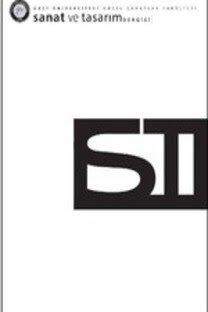Sürdürülebilir Kalkınmada Endüstriyel Tasarımcının Rolü
Çalışmada konu üzerine literatürden derlenen görüşler ışığında, çevreye ve topluma duyarlı tasarım anlayışının - özel sermayedarların ve karma ekonomilerin sistem içerisinde daha fazla üretimin, satın alımın ve tüketimin öngörüldüğü dünyada- nasıl yer edinebileceği, sürdürülebilirlik kavramının tasarım disiplinindeki yeri ve tasarımcının rolü tartışılacaktır. Çalışma endüstri ürünleri tasarımcısının sürdürülebilir kalkınmadaki konumunun tanımlanması ile başlayıp, endüstri ürünleri tasarımı kavramındaki sürdürülebilirliğe doğru tarihsel paradigma değişiminin tartışılması ile devam edecek ve öngörülen süreçte tasarımcının sürdürülebilir kalkınmaya katkıda bulunabileceği yaklaşımların tartışılması ile son bulacaktır.
Anahtar Kelimeler:
sürdürülebilir kalkınma, endüstri ürünleri tasarımı, çevre, toplum, ekonomi
___
- Al-Khafaji, Karim, Margaret Catherine Morse, “Learning Sustainable Design through Service”, International Journal for Service Learning in Engineering, 1, 1, 2006:1.
- Bhamra, Tracy, Vicky Lofthouse, Design for sustainability: A Practical Approach, Gower, Hampshire, 2007.
- Thorpe, Ann, The Designers' Atlas of Sustainability, Island Press, Vaşington, 2007.
- Birkeland, Janis, Design for Sustainability: A Sourcebook of Integrated Eco-logical Solutions, Sterling: Earthscan, 2002.
- Bruntdland, Gro Harlem, ed., Our common future: the World Commission on Environment and Development, Oxford: Oxford University Press, 1987.
- Buchanan, Richard, “Wicked Problems in Design Thinking”, Design Issues, 8, The MIT Press, 2, 1992:5.
- Chapman, Jonathan, Emotionally Durable Design: Objects, Experiences and Empathy, Earthscan, London, 2005.
- Charter, Martin, Tom Clark, Sustainable Innovation: Key conclusions from Sustainable Innovation Conferences 2003–2006 organised by The Centre for Sustainable Design, University College for the Creative Arts, Farnham, 2007.
- Diehl, Jan Carel, Han Brezet, Design for Sustainability: An approach for international development, transfer and local implementation, EMSU 3, 9-11 Haziran 2004, Tecnológico de Monterrey, Campus Monterrey, Monterrey, Meksika, 26 Ocak 2009,(erişim) http://campus- sostenible.mty.itesm.mx/EMSUIII/abstracts/a01_057_j_diehl.pdf, 2004.
- Executive Committee for Destination2026. Activity Report. 2 Şubat 2008, http://openhouse.co.jp/EDI/destination2026/report_e.pdf, 2006 (erişim)
- Fiksel, Joseph, Design for environment: creating eco-efficient products and processes. McGraw-Hill, ABD, 1996
- Graedel, T.E., Braden R. Allenby, Design for environment. Prentice- Hall, NJ, 1996.
- Heskett, John, “Industrial Design”, Design History: a students’ handbook, haz. Hazel Conway, Routledge, New York, 1987
- Kasarda, Mary E., Janis P. Terpenny, Dan Inman, Karl R. Precoda, John Jelesko, Aslı Şahin, Jaeil Park, “Design for adaptability (DFAD)—a new concept for achieving sustainable design”, Robotics and Computer- Integrated Manufacturing, 23, Elsevier, 2007, 2007:727.
- Kyoto Design Declaration signed on March 28, 2008, 3 Nisan 2008, http://www.cumulusassociation.org/index.php?option=com_content& task=view&id=308&Itemid=109, 2008. (erişim)
- Macdonald, Stuart, ed., Design Issues in Europe Today, BEDA, Barselona, 2004.
- Manzini, Ezio, “Design, Environment and Social Quality: From "Existenzminimum" to "Quality Maximum"”, Design Issues , 10, The MIT Press, 1, 1994: 37.
- Manzini, Ezio, Carlo Vezzoli, Garrette Clark, “Product-Service Systems. Using an Existing Concept as a New Approach to Sustainability”, Journal of Design Research, 1, Inderscience, 2, 2001.
- Manzini, Ezio, “Context-based wellbeing and the concept of regenerative solution: A conceptual framework for scenario building and sustainable solutions development”, The Journal of Sustainable Product Design, 2, İngiltre, 3, 2002a:141.
- Manzini, Ezio, “Sustainable solutions. New business ideas and new ideas on business” Encyclopedia of Environmental Management Strategies, Sangyo Chosa-kai, Tokyo, 2002b.
- Margolin, Victor, “Design for a Sustainable World”. Design Issues, 14, The MIT Press, 2, 1998: 83.
- Meurer, Bernd, “New Design Challenges and Concepts”, Design Issues, 15, The MIT Press, 1, 1999:26.
- Mulligan, Joel, Understanding Sustainability: Quality-Of-Life and Opportunities for Design, Carleton University School of Industrial Design's 30th Annual Industrial Design Seminar, Ottava, Ontario, 12 Aralık http://www.icsid.org/education/education/articles695.htm, 2007. 2008, (erişim)
- Nes, Nicole van, Jacqueline Cramer, “Influencing Product Lifetime through Product Design”, Business Strategy and the Environment, 14, John Wiley & Sons, 2005:286.
- Papanek, Victor, The Green Imperative: Ecology and Ethics in Design and Architecture, Thames & Hudson, Londra, 1995.
- Papanek, Victor, Design for the Real World, Academy Chicago Publishers, Şikago, Illinois, 2. Baskı, 1985.
- Ramirez, Mariano, “Sustainability in the education of industrial designers: the case for Australia”, International Journal of Sustainability in Higher Education, 7, Emerald, 4, 2006:189.
- Ramirez, Mariano, Promoting Sustainability through Industrial Design Studio Projects, Connected 2007 International Conference on Design Education, 9-12 Temmuz 2007, University of New South Wales, Sydney, Avustralya, 2007.
- Tischner, Ursula., Eva Schmincke, Frieder Rubik, Martin Prosler, How to do Ecodesign? A Guide for Environmentally and Economically Sound Design, Verlag Form, Frankfurt, 2000.
- UNEP,TUDELFT, Design for Sustainability: a Practical Approach for Developing Economies, UNEP, 2006.
- United Nations Environment Programme, UNEP Annual Report 2005, UNEP.2006.
- Vezzoli, Carlo, "A new generation of designers: perspectives for education and training in the field of sustainable design. Experiences and projects at the Politecnico di Milano University”, Journal of Cleaner Production, 11, Elsevier, 1, 2003: 1.
- Vezzoli, Carlo, Ezio Manzini, Design for Environmental Sustainability, Springer, Londra, 2008.
- Walker, Stuart, Sustainable by Design: Explorations in Theory and Practice, Earthscan, Londra, 2006.
- ISSN: 1308-2264
- Yayın Aralığı: Yılda 2 Sayı
- Başlangıç: 2015
- Yayıncı: Ankara Hacı Bayram Veli Üniversitesi
Sayıdaki Diğer Makaleler
İmgeden Sayısala, Sayısaldan Gerçeğe “ Heykel”
İ. Halil Türker- Nihat Sezer Sabahat
Anadolu'da Toplumsal Yaşamın Mekansal İzleri
Nesnenin Ötesi: Kavramsal Sanatın Dayanak Noktaları
Zaman Kavramı, Avrupa Seramik Masa Ve Şömine Saatleri (18.Yüzyıl Başı- 19.Yüzyıl)
Değer Yaratma Bağlamında Güncel Dört Yenilik Modeli
Çevresel Grafik Tasarım'ın Uygulama Alanları
Sürdürülebilir Kalkınmada Endüstriyel Tasarımcının Rolü
